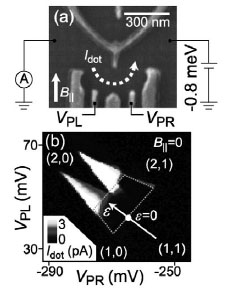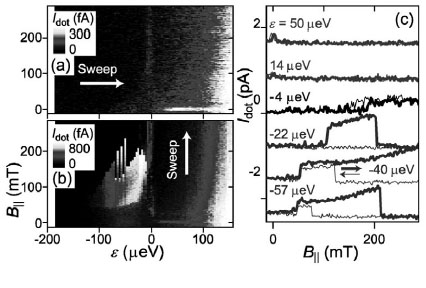1Physical Science Laboratory, 2Tohoku University
Electron spin dynamics in a semiconductor quantum dot (QD) is affected
by the nuclear spin ensemble of the host material. This makes nuclear spin
(NS) manipulation important in view of quantum information processing using
physical qubits based on electron spins in QDs. Recently, we have observed
a hysteretic transport signaling dynamic nuclear spin polarization (DNP)
in a GaAs lateral double QD (DQD) regarded as a promising candidate for
the physical implementation of the spin qubit because of its high controllability
[1]. Magneticfield dependence of this signal suggests strongly unbalanced
DNP between two dots, which is applicable to a rapid manipulation of a
spin qubit.
Figure 1 shows the DQD sample [(a)] and the dot current Idot measured in the few-electron regime [(b)]. Idot is clearly suppressed in the trapezoid region owing to the spin blockade (SB), where transport is blocked whenever parallel-spin electrons singly occupy both two dots.
In the SB region, electron spin relaxation results in leak current reflecting
the spin relaxation mechanism [2]. To investigate this mechanism, we measured
Idot as a function of ε defined by the arrow in Fig. 1(b) and in-plane magnetic
field B||. While the Idot spectrum obtained by ε sweeps at each value of B|| [Fig. 2(a)] does not show any feature at ε < 0, clear Idot enhancement appears over a wide range of ε and B|| in that obtained by up sweeps of B|| at each value of ε [Fig. 2(b)]. Figure 2(c), which displays Idot measured by round sweeps of B||, reveals that this Idot enhancement is hysteretic with respect to the sweep direction of B||. This result indicates DNP occurring for up sweeps of B||, similarly to previous reports on DQDs of different materials and/or shapes
[3]. Furthermore, the gradually escalating current level of this DNP signal
with B|| suggests strongly unbalanced DNP between the two dots, where NSs are polarized
preferentially in one of the two dots.
[1] T. Kobayashi et al., Phys. Rev. Lett. 107 (2011) 216802.
[2] F. H. L. Koppens et al., Science 309 (2005) 1346.
[3] K. Ono and S. Tarucha, Phys. Rev. Lett. 92 (2004) 256803; A. Pfund et al., Phys. Rev. Lett. 99 (2007) 036801; H. O. H. Churchill et al., Nature Phys. 5 (2009) 321.
 |
 |
|||||
|
|